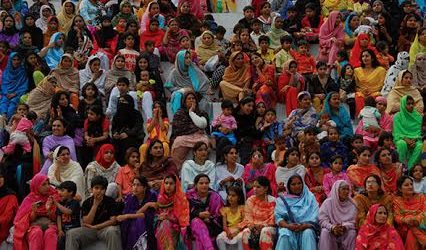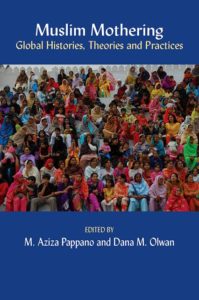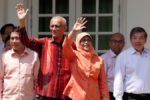Editor’s note: This is the first of two MMW reviews of the book Muslim Mothering: Global Histories, Theories, and Practices.
This article looks at chapters 4, 10, and 11 from Muslim mothering: Global histories, theories, and practices (2016), edited by Margaret Aziza Pappano and Dana M. Olwan. I chose to look at these three chapters because the politico-cultural background of the research participants (Muslims from Malaysia and Indonesia) closely match that of mine as a Malay Muslim woman from Singapore.
For me, the most interesting section was Chapter 4 on Constructing counter-narratives of the “good” Muslim mother in Kuala Lumpur, Malaysia by Audrey Mouser Elegbede (pp. 93-114). This chapter looks at the intersection of race, religion, class, gender and marital status by analysing the experiences of divorced middle-class Malay Malaysian women.
Broadly, the chapter analyses how the context of divorce pulls Muslim women in opposite directions. My personal observations mirror Elegbede’s findings that “women are often still perceived as responsible for marital breakdown (…) because it is the ummah’s expectation that it is a wife’s task to keep her husband sexually satisfied and domestically content.”
While divorce can cast doubt on a woman’s “piety, religious observance, and maternal practice” (p. 98), it can also be a venue for religious validation, if she is granted a divorce “in which she is not cited as having violated the marital contract” (p. 99).
The context of divorce can also influence how these women see Islam. According to the research participants, being divorced helps them seem Islam as a framework that is positive, as it “liberates” them from “social and cultural obstacles”. One participant states,
“[Married] women have not experienced the difficulties [with marriage and social stigmatization as a result of divorced status] that we have. Of course they would see Islam’s constraints as restrictive rather than supportive (…) It is not until they [i.e. currently married women] are divorced that they will see the positive image of single-mothers in Islam.” (p. 94)
A detail I found especially important in this chapter was the adoption of a term used in Malay/Malaysian media. Since 1995, the term ‘ibu tunggal’ (single mother) has since replaced ‘janda’ (divorcee) and ‘balu’ (widow). According to Elegbede, the term ibu tunggal “recognises emotional bonds between parent and child and aligns single mothers with the designated authority and dignity accorded mothers in Islam, regardless of marital status.…[D]ivorced mothers argue that the stigma that they receive in divorce is unwarranted, and that they should retain the dignity, respect, and social capital accorded all mothers in Islam. (p. 104)
What we do here at MMW is based on the premise that media representation has a big influence on people’s perceptions and attitudes. Using politically correct terms goes a long way in correcting our perception of marginalised social groups — an implicit process that is independent of our (often good) intentions.
I found that my personal observations and experiences of Malay Muslim motherhood in Singapore to closely mirror those of Indonesian women, as analysed in by Nina Nurmila in Chapter 10 on Social and religious constructions of motherhood in Indonesia: Negotiating expectations of childbearing, family size and governmental policies. She includes her own experiences as a case study in the chapter.
Like Nina who experienced mothering in both her native country of Indonesia and while studying for her PhD in Australia, I have also had the unique opportunity of mothering in both Singapore and the Netherlands. Like her research participants who “tend to live based on Indonesian culture rather than on the Qur’anic injunctions governing childbirth and mothering”, my motivations for breastfeeding (eventually a little over 2.5 years) came mostly from secular sources of information like the World Health Organisation.
In my case, I found that it’s difficult to isolate religion and/or culture as factors that affect my contraception, breastfeeding and mothering choices. The state and corporations play a major role in influencing religion and/or culture. For example, in the Netherlands where I gave birth, my personal experience was that formula feeding was considered an equal — if not superior — alternative to breastfeeding as it was promoted by most hospitals, doctors, pediatricians and even midwives. This is not unusual once you consider that the country (and its well-marketed cow milk) is the manufacturing site for major Dutch infant formula companies like Similac, Nutrilon and Hero.
Nina describes the popularity of certain contraceptive methods of Indonesian women, with most “prefer[ring] pills and injections (…) because they are easy to use, but they seem not to know the hormonal effects that this form of contraception can have on their breast milk and menstruation schedules.” I experienced something similar at six months postpartum, when my midwife called me to encourage me to start taking hormonal contraceptives as soon as possible, even though I informed her that I was breastfeeding. As I found out later, my preferred method of contraception — Fertility Awareness Method — was not something well-known or popular with any of my social circles.
In Chapter 11, Fatimah Al-Attas looks at the Confinement practices of young Malay Muslim mothers in Malaysia. She found that “mothers will choose practices based on Islamic principles or biomedical explanations over [traditional] humoral explanations.” Depending on their living situation, many couples today find that they have more options in what aspects of confinement they choose to practise (or not).
I gave birth in the Netherlands and practised only a few confinement practices, such as wearing the ‘bengkung’ (postpartum belly wrapping) and eating certain foods. While I would have like to have adopted other practices, I simply did not have the choice as there was no traditional Malay postpartum midwife at my disposal. While the article suggests that many Malay mothers today pick and choose practices based on reasons other than pure culture, such as religion or biomedical explanation, my personal observations suggest otherwise.
Many of my peers — urban, educated middle-class Malay women — strictly followed confinement practices, even to the point of not leaving the house at all during the 40-day period. Much of this can be attributed to the practice of staying in their mother’s house during the confinement period, which makes resistance against the rituals more difficult. Even among the very educated and religious women, one of their motivations for doing so may be the fear of the consequences of not doing so: loss of libido or sexual ability, or being unable to restore their body to pre-baby appearance.
In closing and reflecting on these chapters and my own personal experiences, as I grow as a mother, I continually discover that my choices are extremely marginal. Hence, I find basing my motherhood identity on a certain religion and/or culture becomes increasingly difficult. The question I ask myself often is, am I a Malay and Muslim mother because of my parenting practices, or are my practices part of Malay Muslim motherhood because that’s who I am?



